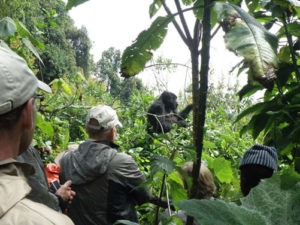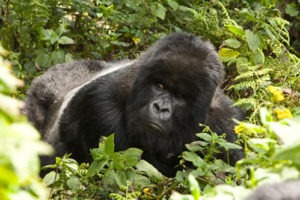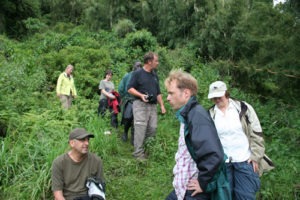Gorilla trekking is one of the most popular wildlife activities in Africa. People travel from all parts of the world with the aim of spotting these amazing primates. Almost everyone, be it an adult, youth or child is fascinated by gorillas. Many take that fascination to the next level by deciding to see the gorillas in their natural setting –an activity called gorilla trekking. Gorilla trekking is mostly carried out in three African countries (Uganda, Rwanda and the Democratic Republic of Congo). Most trekking in these countries is related to finding mountain gorillas and the larger Eastern Lowland Gorilla. Mountain gorillas are the most visited and can be found in Rwanda, Uganda and the Democratic Republic of Congo.
 Gorilla Trekking has rules and regulations guiding it and one of them is the age limit for trackers. For a person to take part in gorilla trekking, they must be 15 years and above. The age limit for gorilla trekking has been an obstacle for travelers who wish to register for the activity but with their children who are below the age of 15. It’s always a big blow to the parents when a tour operator informs them that their kids will not be allowed to join them for gorilla trekking. Some of the parents will plead with the tour operator to find a way of letting their children join them during trekking. Most tour operators will decline helping the parents because of the strict rules regarding gorilla trekking. We will discuss why children are not allowed to track gorillas, circumstances under which they might be allowed and under what conditions.
Gorilla Trekking has rules and regulations guiding it and one of them is the age limit for trackers. For a person to take part in gorilla trekking, they must be 15 years and above. The age limit for gorilla trekking has been an obstacle for travelers who wish to register for the activity but with their children who are below the age of 15. It’s always a big blow to the parents when a tour operator informs them that their kids will not be allowed to join them for gorilla trekking. Some of the parents will plead with the tour operator to find a way of letting their children join them during trekking. Most tour operators will decline helping the parents because of the strict rules regarding gorilla trekking. We will discuss why children are not allowed to track gorillas, circumstances under which they might be allowed and under what conditions.
Why are there age limits for Gorilla Trekking?
 One of the reasons why people below 15 years are restricted from gorilla trekking is because they are considered immature and may be intimidated by the size of a gorilla. The massive size of a silverback and his serious appearance is intimidating to even some adults. Silverbacks and even other members of the group may make a mock charge. A child may scream and run away attracting more attention from the primates. Tourists are advised never to run away when a gorilla charges or pretends to do so. The solution is to lay low and act submissive. That requires great maturity and discipline given the size and noise coming out of a charging gorilla. Gorillas take running away as a confirmation of ill intentions.
One of the reasons why people below 15 years are restricted from gorilla trekking is because they are considered immature and may be intimidated by the size of a gorilla. The massive size of a silverback and his serious appearance is intimidating to even some adults. Silverbacks and even other members of the group may make a mock charge. A child may scream and run away attracting more attention from the primates. Tourists are advised never to run away when a gorilla charges or pretends to do so. The solution is to lay low and act submissive. That requires great maturity and discipline given the size and noise coming out of a charging gorilla. Gorillas take running away as a confirmation of ill intentions.
Gorillas share about 98% of the human DNA. Because of that, humans can spread diseases to them. Children tend to have a weaker immunity which is evidenced by the fact they frequently get flu and  colds. They can easily transmit these diseases to the primates. Humans have evolved to deal with flu but it can affect gorillas badly leading to serious illness or death.
colds. They can easily transmit these diseases to the primates. Humans have evolved to deal with flu but it can affect gorillas badly leading to serious illness or death.
Children may be fit but not mentally prepared to deal with the challenges of walking long distances in search of gorillas. They may get tired, thirsty or hungry and request to go back to the lodge. This lack of patience may force their parents to cancel an otherwise amazing activity or cause disruption to other tourists.
Last but not least, Kids tend to be clumsy and reckless. They may find it difficult to adhere to the rules and regulations for gorilla trekking. Some of the gorilla trekking rules include avoiding unnecessary movements and noise. Other rules include not littering the park and keeping a 7 meter gap with the nearest primate.
Is there a workaround to allow gorilla trekking for kids?
The age limit of gorilla trekking is 15 years but there is a provision which allows children who are between 13 and 14 years to do gorilla trekking. This is only possible in Bwindi Impenetrable National Park. The parent must write a letter requesting the Uganda Wildlife Authority to let their kid engage in the activity. If approved, the parent accepts to take responsibility in case of an incident while in the forest. This written request must be received early enough and before the activity – At least three months before showing up.
In case the child is not allowed to take part in the activity, the parent can still travel with him/her. The parents will proceed for gorilla trekking and leave the child to take part in other activities which have no age restrictions. These activities include nature walks and community tours in villages close to the national park. The children can be left with the Tour Driver/Guide or hotel staff.


